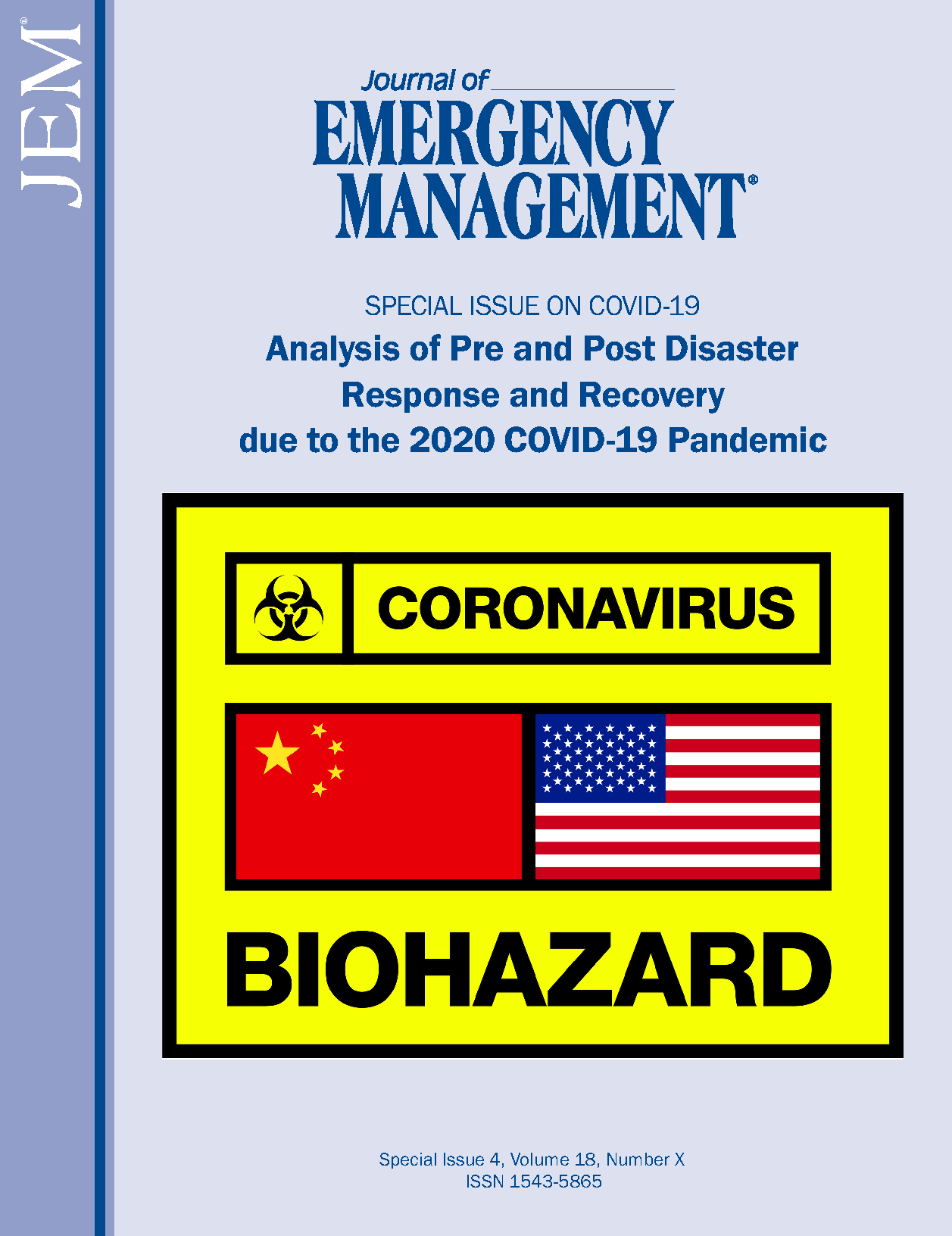A systems approach for resources management during the COVID-19 pandemic: Multi-agency perspectives from New England
DOI:
https://doi.org/10.5055/jem.0546Keywords:
COVID-19, systems modeling, resource distributionAbstract
The emergence of COVID-19 in the United States has overwhelmed local hospitals, produced shortages in critical protective supplies for medical staff, and created backlogs in burials and cremations. Because systemic disruptions occur most acutely at a local scale, facilitating resource coordination across a broad region can assist local responses to COVID-19 surges. This article describes a structured systems approach for coordinating COVID-19 resource distribution across the six New England states of the United States. The framework combines modeling tools to anticipate resource shortages in medical supplies, personnel needs, and fatality management for individual states. The approach allows decision makers to understand the magnitude of local outbreaks and equitably allocate resources within a region based on the present and future needs. This model contributed to determining material distribution in New England as the 2020 COVID-19 surges unfolded in the spring and fall seasons. Using a systems analysis, the model demonstrates the translation of anticipated COVID-19 cases into resource demands to enable regional coordination of scarce resources.
References
Witte G: In educated and affluent Massachusetts, coronavirus cases surged. The decline has yet to come. The Washington Post. Available at https://www.washingtonpost.com/national/coronavirus-massachusetts-cases-high/2020/05/01/8b7b748c-8b2b-11ea-8ac1-bfb250876b7a_story.html. Accessed July 28, 2020.
Entress R, Tyler J, Sadiq A-A: Managing mass fatalities during COVID-19: Lessons for promoting community resilience during global pandemics. Public Adm Rev. 2020; 80(5): 856–861.
erdc-cv19, erdc-cv19/seir-model. 2020. Available at https://github.com/erdc-cv19/seir-model. Accessed May 5, 2020.
Chowell G, Sattenspiel L, Bansal S, et al.: Mathematical models to characterize early epidemic growth: A review, Phys Life Rev. 2016; 18: 66–97.
Li MY, Graef JR, Wang L, et al.: Global dynamics of a SEIR model with varying total population size. Math Biosci. 1999; 160: 191–213.
Center for Disease Control (CDC): COVID-19 mathematical modeling. Available at https://www.cdc.gov/coronavirus/2019-ncov/covid-data/mathematical-modeling.html. Accessed October 29, 2020.
CU Shaman Group: COVID-19 findings, simulations. Available at https://blogs.cuit.columbia.edu/jls106/publications/covid-19-findings-simulations/. Accessed October 29, 2020.
Mari GM: A 10-step guide to convert a surgical unit into a COVID-19 unit during the COVID-19 pandemic. Int J Surg. 2020; 78: 113–114.
Parker AM, Liu X, Harris AD, et al.: Respiratory therapy organizational changes are associated with increased respiratory care utilization. Respir Care. 2013; 58: 438–449.
West AJ, Nickerson J, Breau G, et al.: Staffing patterns of respiratory therapists in critical care units of Canadian teaching hospitals. Can J Respir Ther. (CJRT = Revue Canadienne de La Therapie Respiratoire: RCTR). 2016; 52: 75.
Afshar M, Dumanian J: Maine_COVID_Resources_040 120v4.ppt. 2020.
Center for Disease Control (CDC): Use personal protective equipment (PPE) when caring for patients with confirmed or suspected COVID-19, 2020. Available at https://www.cdc.gov/coronavirus/2019-ncov/downloads/A_FS_HCP_COVID19_PPE.pdf?fbclid=IwAR3iqIjc593mHLhvOtcOj4KVeU9_N1DqlDi9DuZY_MEJVlvIG6Kmxt5k7KI. Accessed May 11, 2020.
Center for Disease Control (CDC): Strategies to optimize the supply of PPE and equipment. 2020. Available at https://www.cdc.gov/coronavirus/2019-ncov/hcp/ppe-strategy/index.html. Accessed July 8, 2020.
Yuki K, Fujiogi M, Koutsogiannaki S: COVID-19 pathophysiology: A review. Clin Immunol. 2020; 215: 108427.
American Lung Association: Learn about COVID-19: How it infects your body. Available at https://www.lung.org/lung-health-diseases/lung-disease-lookup/covid-19/about-covid-19#:~:text=In%20the%20early%20days%20of,airways%20with%20debris%20and%20fluids. Accessed August 5, 2020.
Grasselli G, Zangrillo A, Zanella A, et al.: Baseline characteristics and outcomes of 1591 patients infected with SARS-CoV-2 admitted to ICUs of the Lombardy Region, Italy. JAMA. 2020; 323: 1574–1581.
Liu Y, Yan L-M, Wan L, et al.: Viral dynamics in mild and severe cases of COVID-19, Lancet Infect Dis. 2020; 20(6): P656–P657.
Wunsch H, Wagner J, Herlim M, et al.: ICU occupancy and mechanical ventilator use in the United States. Crit Care Med. 2013; 41(12): 2712.
Center for Disease Control (CDC): CDC WONDER: Detailed mortality. Available at https://wonder.cdc.gov/. Accessed October 29, 2020.
Berger P: As coronavirus deaths surge, New York City allows cremations 24 hours a day. Wall St J. (2020). Available at https://www.wsj.com/articles/as-coronavirus-deaths-surge-new-york-city-allowscremations-24-hours-a-day-11585929876. Accessed June 26, 2020.
Petri AA: The Mortuary Professor Who “Came out of Nowhere” to Help N.Y.C. New York Times. Available at https://www.nytimes.com/2020/04/22/nyregion/coronavirus-deaths-cremation-mortician.html. Accessed June 26, 2020.
Hynes W, Trump BD, Love P, et al.: Bouncing forward: A resilience approach to dealing with COVID-19 and future systemic shocks. Environ., Sys., Decisions, 40(2); 2020: 174-184.
Trump BD, Bridges TD, Cegan JC, et al.: An analytical perspective on pandemic recovery. Health Security, 2020; 18(3): 250-256. DOI: 10.1089/hs.2020.0057.
Linkov I, Keenan J, Trump BD: COVID-19: Systemic Risk and Resilience. Amsterdam, The Netherlands: Springer, 2021.
Published
How to Cite
Issue
Section
License
Copyright 2007-2025, Weston Medical Publishing, LLC and Journal of Emergency Management. All Rights Reserved.






